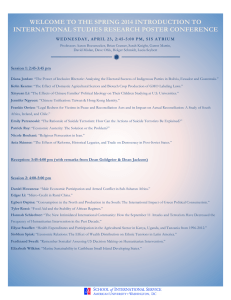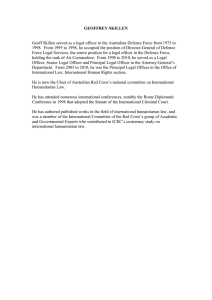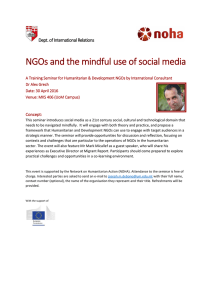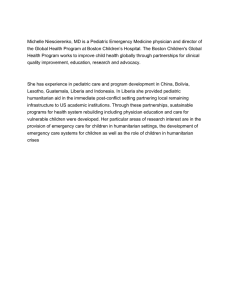Designing Humanitarian Engineering Classes Session T3H
advertisement
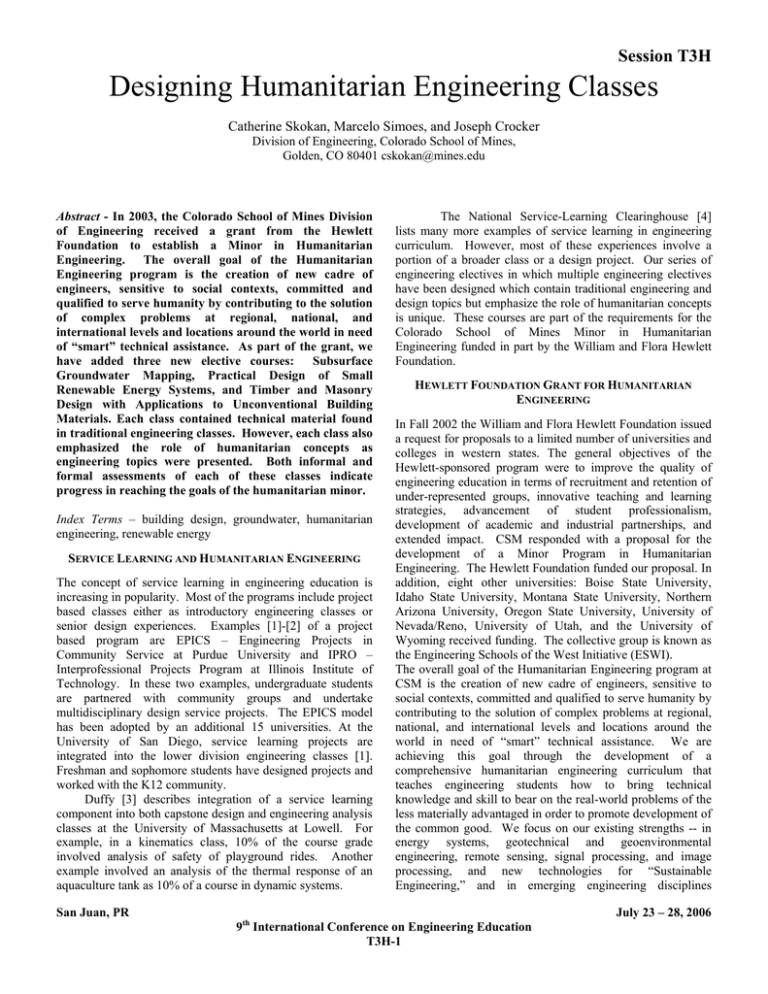
Session T3H Designing Humanitarian Engineering Classes Catherine Skokan, Marcelo Simoes, and Joseph Crocker Division of Engineering, Colorado School of Mines, Golden, CO 80401 cskokan@mines.edu Abstract - In 2003, the Colorado School of Mines Division of Engineering received a grant from the Hewlett Foundation to establish a Minor in Humanitarian Engineering. The overall goal of the Humanitarian Engineering program is the creation of new cadre of engineers, sensitive to social contexts, committed and qualified to serve humanity by contributing to the solution of complex problems at regional, national, and international levels and locations around the world in need of “smart” technical assistance. As part of the grant, we have added three new elective courses: Subsurface Groundwater Mapping, Practical Design of Small Renewable Energy Systems, and Timber and Masonry Design with Applications to Unconventional Building Materials. Each class contained technical material found in traditional engineering classes. However, each class also emphasized the role of humanitarian concepts as engineering topics were presented. Both informal and formal assessments of each of these classes indicate progress in reaching the goals of the humanitarian minor. Index Terms – building design, groundwater, humanitarian engineering, renewable energy SERVICE LEARNING AND HUMANITARIAN ENGINEERING The concept of service learning in engineering education is increasing in popularity. Most of the programs include project based classes either as introductory engineering classes or senior design experiences. Examples [1]-[2] of a project based program are EPICS – Engineering Projects in Community Service at Purdue University and IPRO – Interprofessional Projects Program at Illinois Institute of Technology. In these two examples, undergraduate students are partnered with community groups and undertake multidisciplinary design service projects. The EPICS model has been adopted by an additional 15 universities. At the University of San Diego, service learning projects are integrated into the lower division engineering classes [1]. Freshman and sophomore students have designed projects and worked with the K12 community. Duffy [3] describes integration of a service learning component into both capstone design and engineering analysis classes at the University of Massachusetts at Lowell. For example, in a kinematics class, 10% of the course grade involved analysis of safety of playground rides. Another example involved an analysis of the thermal response of an aquaculture tank as 10% of a course in dynamic systems. The National Service-Learning Clearinghouse [4] lists many more examples of service learning in engineering curriculum. However, most of these experiences involve a portion of a broader class or a design project. Our series of engineering electives in which multiple engineering electives have been designed which contain traditional engineering and design topics but emphasize the role of humanitarian concepts is unique. These courses are part of the requirements for the Colorado School of Mines Minor in Humanitarian Engineering funded in part by the William and Flora Hewlett Foundation. HEWLETT FOUNDATION GRANT FOR HUMANITARIAN ENGINEERING In Fall 2002 the William and Flora Hewlett Foundation issued a request for proposals to a limited number of universities and colleges in western states. The general objectives of the Hewlett-sponsored program were to improve the quality of engineering education in terms of recruitment and retention of under-represented groups, innovative teaching and learning strategies, advancement of student professionalism, development of academic and industrial partnerships, and extended impact. CSM responded with a proposal for the development of a Minor Program in Humanitarian Engineering. The Hewlett Foundation funded our proposal. In addition, eight other universities: Boise State University, Idaho State University, Montana State University, Northern Arizona University, Oregon State University, University of Nevada/Reno, University of Utah, and the University of Wyoming received funding. The collective group is known as the Engineering Schools of the West Initiative (ESWI). The overall goal of the Humanitarian Engineering program at CSM is the creation of new cadre of engineers, sensitive to social contexts, committed and qualified to serve humanity by contributing to the solution of complex problems at regional, national, and international levels and locations around the world in need of “smart” technical assistance. We are achieving this goal through the development of a comprehensive humanitarian engineering curriculum that teaches engineering students how to bring technical knowledge and skill to bear on the real-world problems of the less materially advantaged in order to promote development of the common good. We focus on our existing strengths -- in energy systems, geotechnical and geoenvironmental engineering, remote sensing, signal processing, and image processing, and new technologies for “Sustainable Engineering,” and in emerging engineering disciplines San Juan, PR July 23 – 28, 2006 9th International Conference on Engineering Education T3H-1 Session T3H including, bioengineering, information systems, and micronano- systems. These capabilities are applied to the solution of problems for areas and people who can benefit from engineering expertise. This objective is particularly relevant to the CSM, a school with a long tradition of leadership in resource and minerals fields, but with a strong commitment to stewardship of global resources. Four specific goals of the Humanitarian Engineering program were defined in the original proposal: (1) Create a culture of acceptance and value of community and international service activities at CSM. The goal is to create an enhanced appreciation of the value and importance of the participation of engineers in community and international service. (2) Increase the number of CSM engineering graduates that enter occupations that have a community or international service emphasis. Although this is a long time goal, we anticipate measurable changes in employment patterns by the conclusion of the grant. (3) Increase the recruitment of women and minority students to the engineering program at CSM. As a result of new recruitment activities that emphasize service and our K-12 outreach activities, we anticipate an increase in applications from women and minority students. (4) Increase the number of engineering students that enter internships in community or international service. NEW HUMANITARIAN ENGINEERING ELECTIVE COURSES The Minor Program in Humanitarian Engineering requires 15 credit hours of classes in the Liberal Arts area, 3 credit hours of Multidisciplinary Engineering Laboratory, a humanitarian capstone Senior Design experience as well as 3 credit hours of humanitarian designated engineering classes. The liberal arts classes include a choice of three classes from a list that contains Introduction to Ethics, Political Philosophy and Engineering, Engineering Cultures in the Developing World, Technical Writing for Service Learning, or Technology and International Development. Students must also take two area studies classes highlighting a region of the world: United States, Latin America, Asia, or Africa and the Middle East. An emphasis on multidisciplinary engineering skills has been enhanced by the addition of liberal arts skills. A series of new humanitarian-engineering based projects have been added to the Multidisciplinary Engineering Laboratory, also. I. Subsurface Mapping of Groundwater This course (see Table I for Syllabus) investigated the physical properties of groundwater, contaminants, and surrounding media. Survey tools, including electrical, electromagnetic, radar, seismic methods to map groundwater and contamination were discussed. For each tool, field parameters, cost, depth of penetration, accuracy, and interpretation limitations were explored. Emphasis was placed on how measurements were made and not on the underlying theory of each method. Special consideration was given to planning and carrying out these surveys in remote or economically disadvantaged regions. Case histories, including those undertaken at CSM [ 5] – [8], were an integral part of the course. Week 1 2 3 4 5 6 7 8 9 10 11 12 13 14 15 16 TABLE I SUBSURFACE GROUNDWATER MAPPING SYLLABUS Topic Assignment Introduction, Definition of Groundwater Electrical methods, DC, SP Electrical Field Field Memo – field parameters, data Experience reduction and interpretation Electrical Case Oral and written report Histories EM Systems EM Field Field Memo EM Cases Oral and written report EXAM I Take-home Radar Radar Field Field Memo Radar Cases Oral and written report Seismic Seismic Field Field Memo Seismic Cases Oral and written report EXAM II Take-home Final Presentation Team effort on take-home exam case Assessment of the students in the course included field reports, oral and written presentations of case histories, and two take-home exams. The exams required the students to design a groundwater exploration program. After reviewing the first exam, the instructor discovered that the students had approached the same problem from different directions and that they would gain additional learning by working as a team. For the final exam, each student designed a survey individually. Then, teams of students combined their designs into a final design and presentation. Both the team and individual results were assessed. Below is the first exam: San Juan, PR July 23 – 28, 2006 9th International Conference on Engineering Education T3H-2 Session T3H Take-home Examination The surrounding villages near Kabul, Afghanistan want to develop aquifers for a town water supply. The hydrogeological situation is determined by three rivers, Kabul, Paghman, and Qargha flowing into a basin. Sandygravelly sediments are targets for suitable warter development. Geologists believe there is an aquifer situated below a partly sandy, partly clayey overburden. An area of 10 km by 10 km west of Kabul is of interest. Two wells in the area show that the depth to older sediments (marls) is 60 – 70 meters. The aquifer lies in the sand and gravel of younger sediments at a depth of 10 – 15 meters. (The fresh water aquifer could be more resistive than the basement marls and overburden clay.) Design a survey plan to attack this problem. In your design, be sure to include additional information about the area, physical properties variations that will be measured, geophysical tools to use and to reject, an estimate of the character of the data, the survey parameters, survey cost, and social and political considerations. How will you report your information to the village elders? II. Practical Design of Small Renewable Energy Systems This course was designed to cover practical topics related to the design of alternative energy based systems (see Table II for syllabus). It was assumed that students had some basic and broad knowledge of the principles of electrical machines, thermodynamics, electronics, and fundamentals of electric power systems. One of the main objectives of this course was to focus on the interdisciplinary aspects of integration of the alternative sources of energy, including hydropower, wind power, photovoltaic, gas, biomass and energy storage for those systems. Power electronic systems and how inverters can be used for stand-alone and grid-connected electrical energy applications [9] were discussed. Homework assignments prepared students for a final project to design a renewable energy system for a developing region: Final Class Project You are required to present a seminar and prepare a portfolio and comprehensive technical paper formatted in IEEE style. The topic must be a case study on renewable energy and distributed power generation. Requirements also include a discussion of preparation of you team as you travel to a remote location to design and implement a renewable energy system outside of the United States, the relevance of the project to the community, and the social impact of the project. TABLE II. PRACTICAL DESIGN OF SMALL RENEWABLE ENERGY SYSTEMS SYLLABUS Week Topic Assignment 1 Introduction, Essay on team work and design of a Energy, World small renewable energy system outsife Fossil Fuel of the US REserves 2 Small Scale Summary – Definition of distributed Renewable Energy generation Systems and importance in humanitarian projects 3 Power Distribution, Transmission, Environmental Interaction 4 Small Hydro Power Summary – Remote Micro-HydroSystems, Turbines electric Power Generation 5 Small PV Systems, Summary – PV systems Social Value 6 Wind Energy Table on Wind Turbines 7 Electric Generators 8 Renewable Systems Memo – Social Values 9 Control of Summary – Hybrid Power Systems Renewable Systems with Controlled Energy Source 10 Micropower Design Solar Pump System Optimization 11 EXAM I 12 Sustainability 13 Logistics 14 Safety 15 Project Final Report Presentations 16 Project Final Seminar Presentations This course (see Table III for syllabus) provided students with a fundamental understanding of the structural systems utilized in the design of basic building structures. It familiarized students with both gravity load and lateral load resisting systems and the integration of the systems that is required to design and construct stable structures. Students developed an understanding of the basic engineering properties of timber and masonry materials and became familiar with design methods and philosophies for timber, masonry, and hybrid structures. They developed the skills required to evaluate the suitability of structural systems for maintaining stability during weather and earthquake events. San Juan, PR July 23 – 28, 2006 9th International Conference on Engineering Education T3H-3 Session T3H TABLE III. TIMBER AND MASONRY DESIGN WITH APPLICATIONS TO UNVONVENTIONAL BUILDING MATERIALS SYLLABUS Week Topic Assignment 1 Introduction, Loads 2 Loads Load Hmwk 3 Structural Behavior Building Codes Hmwk 4 Wood Properties Properties Hmwk 5 Wood Beam Design 6 Axial and Combined Allowable Stress Design Forces 7 Horizontal Bending and Axial Load Hmwk Diaphragms 8 Wood Shearwalls Shear and Combined Loading Hmwk 9 EXAM I 10 Properties of Masonry 11 Columns 12 Walls Masonry Design Hmwk 13 Walls 14 Project Presentations Projects 15 Project Presentations Projects 16 EXAM II The students had the opportunity to develop their research, analysis, and design skills while completing one of several design projects assigned during the last half of the course. Each project required that the design team explore and provide conceptual structural design information for a structure located in another country. Each structural problem has aspects that require the team to draw on: the materials presented during the course; their ability to work as a team; and their ability to research and understand local problems and local perspectives. Teams were given opportunities to work with both conventional and “unconventional” materials (adobe, timber pole, bamboo, stone, etc.) such as those used in constructing structures in developing, or less developed countries. Solutions were limited by local needs, wants, and material availability. An example of a project for Pakistan illustrates how students must integrate their engineering skills with their knowledge of the local community: Example Class Project You have been sent to northern Pakistan to assist villagers recovering from the latest earthquake. All housing in their village was destroyed during the quake. You are the only structural engineer in the aid party. It is your job to assist the villagers in developing a basic shelter design for their use as a family home. Using local materials and building methods your goal is to provide the villagers with design options, enhancements, and concepts that will improve the performance of their housing structures during a seismic event. There is access to the area by truck for the importation of a limited amount of building supplies. The housing must be available before the next winter season. ASSESSMENT An assessment program of the entire Humanitarian Engineering Program, consisting of attitudinal and course evaluation surveys, regular team meetings, and pilot classes has been undertaken for the last three years. The attitudinal survey reveals that both students and faculty members maintain positive attitudes toward humanitarian objectives, although faculty attitudes are slightly more positive, and faculty have less interest in the associated career paths. [10]. Assessment of the program toward Goal 1 (concept acceptance) will continue for two more years. Progress toward diversity (goal 3) particularly in the area of gender has been particularly encouraging [11]. For these new electives, the percentage of females was 100% for the groundwater mapping course, 25 % for the building materials class, and 12.5 % for the renewable energy offering. The university average is 22% female. Goals 2 and 4 which address career choices in the area of humanitarian engineering will require more long-term data collection. From informal comments of present students, indicate that some forward steps have been made in this direction. Continuing assessment is required to further evaluate these goals. The course assessments for the three new engineering electives are also encouraging. Full assessment of the Subsurface Groundwater Mapping class is complete because the course was offered in the Fall Semester, 2005. Assessment is on-going in the other two classes offered in Spring Semester, 2006. For the groundwater course, the students ranked the relevancy of the class at 3.75 out of a possible 4. The engineering department average on this question is 3.0. In informal assessment, the students commented: • “This is the most practical class I have ever taken.” • “I want to investigate graduate studies in humanitarian engineering.” • “This is one of the best classes I’ve had – an interdisciplinary, extremely hands-on course incorporating many different disciplines, geophysics, humanitarian engineering, civil engineering, and hydrology.” An informal survey of the students in the building materials class showed that 90% of the respondents thought the material presented and the class experience better prepared them to work on structures constructed of either conventional or unconventional materials and in locations with limited resources. Some commented that the humanitarian direction was something that had not previously considered but would now. FUTURE DIRECTIONS The Engineering Division has been active in course development for the Humanitarian Engineering Minor with a variety of multidisciplinary topics. Courses currently offered include alternative energy sources, groundwater mapping, unconventional building materials. In addition, two engineering electives previously offered have been included in the humanitarian minor elective list: biomedical San Juan, PR July 23 – 28, 2006 9th International Conference on Engineering Education T3H-4 Session T3H instrumentation and musculoskeletal biomechanics. Future classes in the areas of ecological waster water treatment, and slope stability, applications of control systems, pollutant transport in soils, and image analysis for disaster relief are planned. All engineering students are required to take at least two technical electives. The humanitarian electives can count toward one or both of these required classes. It is our hope that both students participating in the humanitarian minor, as well as those who are not, will participate in these offerings so that a broader group of students will become sensitive to this facet of engineering. ACKNOWLEDGMENT We gratefully acknowledge the William and Flora Hewlett Foundation for their financial support of the Humanitarian Engineering Program at the Colorado School of Mines. Without their help, development of these courses would not have been possible. REFERENCES [1] Oakes, W., et al, “Service Learning in Engineering”, FIE Conference, Boston, MA, 2002. [2] EPICS National, “National Program”, http://epicsnational.ecn.purdue.edu/ public/program/national_program.php, accessed 4/06. [3] Duffy, J. , “Service Learning in a Wide Variety of Engineering Courses”, http://energy.caeds.eng.uml.edu/slearn.html, 2001. [4] Campus Compact, “Service-Learning Syllabi – Engineering”, http://www.servicelearning.org/resources/quick_guides/eng_ed/, accessed 4/06. [5] Khair, K. and Skokan, C., “A model Study of the Effect of Salination on Groundwater Resistivity”, Jour. Envir. and Eng Geophysics, Vol. 2, No. 3, 1998. [6] Skokan, C. K., “Senegal – Irrigation and Water Quality Project”, FastTimes, EEGS, Vol. 9, No. 3, 2004. [7] Skokan, C. K., and Munoz, D., “A Groundwater Study in Colinas de Suiza, Villanueva, Honduras”, SAGEEP Conference, Seattle, WA, 2006. [8] Skokan, C. K., Munoz, D., and Gosink, J., “Humanitarian Projects in Interdisciplinary Senior Design, ICEE, Gliwice, Poland, 2005. [9] Farret, F. A., and Simoes, M. G., “Integration of Alternative Sources of Energy”, Wiley-IEEE Press, 2006. [10] Bauer, E. H., et al, “Understanding Student and Faculty Attitudes with Respect to Service Learning: Lessons from the Humanitarian Engineering Project”, ASEE Conference, Portland, OR, 2005. [11] Skokan, C. K, and Josink, J, “Gender Participation in Humanitarian versus Traditional Multidisciplinary Senior Design Projects”, ASEE Conference, Portland, OR, 2005. San Juan, PR July 23 – 28, 2006 9th International Conference on Engineering Education T3H-5



